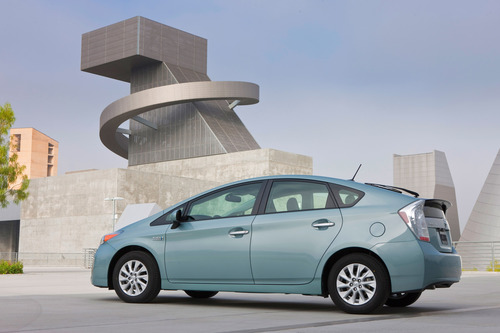As the Toyota Prius Plug-in makes its way towards dealer show-rooms, Toyota announces that, in California, the Prius Plug-in will qualify for an additional rebate under the CVRP program, and additionally qualifies for the same green HOV access sticker that the Chevy Volt will get.
The Toyota Prius Plug-in is making its way towards dealer show-rooms and Toyota is announcing today the car is qualified for California’s Clean Vehicle Rebate Program (CVRP). This is an additional rebate, in California, on top of the Federal plug-in vehicle tax credit.
The Federal tax credit for plug-in cars was originally enacted under the Bush Administration and expanded during the Obama Administration. Under the federal program the Toyota Prius Plug-in qualifies for a $2500 tax credit, due to the size of its battery pack.
California’s Clean Vehicle Rebate Program (CVRP) is funded by the Air Resources Board, and supports zero emission vehicles, plug-in hybrid electric vehicles, neighborhood electric vehicles, and zero emission motorcycles. Under the CVRP, the Toyota Prius Plug-in qualifies for a $1,500 rebate, and will be available on a first-come-first-served basis. According to the CVRP website, there is $7,283,487 remaining for rebates under the program. The rebate applies either to cars purchased new, or leased for a 36 month or longer period.
The last, and maybe more important item, is that the Prius Plug-in qualifies for the coveted white stickers granting access to the HOV lane on California highways. Originally the purpose of the HOV lane was to encourage carpooling rather than solo driving, in an effort to reduce traffic congestion and greenhouse gas emissions. However HOV access for solo drivers of clean vehicles has also been used as a perk to encourage adoption of clean vehicles. Originally HOV access stickers were granted to the early hybrid cars as well as pure electric and CNG powered cars, with the different types of cars having different colored
stickers. The gold stickers for the original hybrid cars expired a couple years ago, but the sticker program for electric and CNG cars is still in existence. Hybrid cars are so popular today that it’s recognized they no longer need this perk, while electric cars have yet to become popular, and still need the perk. The Prius Plug-in qualifies under a new green sticker that came into effect on Jan 1, 2012, and is meant for cars meeting California’s enhanced advanced technology partial zero emission vehicle (AT PZEV) requirements. The only other car which qualifies for this new green HOV sticker is the Chevy Volt.
The Prius Plug-in![]() is essentially a Prius Liftback with a larger battery pack. It uses Toyota’s Hybrid Synergy Drive system, configured to allow electric-only driving at speeds up to 62 miles/hr. The 4.4 kilowatt-hour lithium-ion battery pack allows up to 11 miles (or so) of all-electric driving. In EV mode it’s EPA rated for 95 miles/gallon equivalent (MPGe), and in hybrid mode it has a combined mileage rating of 50 MPG. Because the battery pack is so small, charging time is only 2.5-3 hours using a standard 120V outlet or 1.5 hours using 240V.
is essentially a Prius Liftback with a larger battery pack. It uses Toyota’s Hybrid Synergy Drive system, configured to allow electric-only driving at speeds up to 62 miles/hr. The 4.4 kilowatt-hour lithium-ion battery pack allows up to 11 miles (or so) of all-electric driving. In EV mode it’s EPA rated for 95 miles/gallon equivalent (MPGe), and in hybrid mode it has a combined mileage rating of 50 MPG. Because the battery pack is so small, charging time is only 2.5-3 hours using a standard 120V outlet or 1.5 hours using 240V.
The base MSRP for the Prius Plug-in Hybrid is $32,000. The Prius Plug-in Hybrid Advanced, which adds Toyota’s ENTUNE infotainment system, has an MSRP of $39,525. Under the programs listed above, in California both of these cars qualify for $4,000 of government-supported consumer incentives ($2,500 federal tax credit, $1,500 CVRP tax rebate).
At launch, the Prius Plug-in Hybrid will be available in the following 14 states: California, Oregon, Washington, Arizona, Maine, Massachusetts, Vermont, New Hampshire, Rhode Island, Connecticut, New York, New Jersey, Maryland, and Virginia. A national rollout of Prius Plug-in is planned for 2013.
Originally published at TorqueNews: http://www.torquenews.com/1075/toyota-confirms-prius-plug-qualifies-california-rebate-program
- Highway design could decrease death and injury risk, if “we” chose smarter designs - March 28, 2015
- GM really did trademark “range anxiety”, only later to abandon that mark - March 25, 2015
- US Government releases new regulations on hydraulic fracturing, that some call “toothless” - March 20, 2015
- Tesla Motors magic pill to solve range anxiety doesn’t quite instill range confidence - March 19, 2015
- Update on Galena IL oil train – 21 cars involved, which were the supposedly safer CP1232 design - March 7, 2015
- Another oil bomb train – why are they shipping crude oil by train? – Symptoms of fossil fuel addiction - March 6, 2015
- Chevron relinquishes fracking in Romania, as part of broader pull-out from Eastern European fracking operations - February 22, 2015
- Answer anti- electric car articles with truth and pride – truth outshines all distortions - February 19, 2015
- Apple taking big risk on developing a car? Please, Apple, don’t go there! - February 16, 2015
- Toyota, Nissan, Honda working on Japanese fuel cell infrastructure for Japanese government - February 12, 2015











